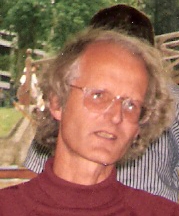Sjur Refsdal

Sjur Refsdal (30 December 1935 – 29 January 2009) was a
Biography
In 1970 he earned a doctorate at the Institute of Theoretical Astrophysics, University of Oslo. Later that year he became professor in astrophysics at the Hamburg Observatory[1] in Germany, and remained in that position until he retired in 2001.
In 1964 and 1966 he published a series of articles on the effects and possible applications of gravitational lenses.
He was a member of the
The first detected multiply-lensed supernova was nicknamed "SN Refsdal" in his honor.[6][7]
References
- ^ Obituary, Hamburg Observatory
- ^ P. Schneider, J. Ehlers, E.E. Falco, Gravitational Lenses, Springer-Verlag, Berlin 1999. Chapter The period 1963-1979 at Google Books
- .
- S2CID 119483238.
- ^ Obituary Archived 2009-03-03 at the Wayback Machine, Institutt for Teoretisk Astrofysikk, 2. February 2009
- S2CID 206633888.
- New York Times. Retrieved March 5, 2015.
